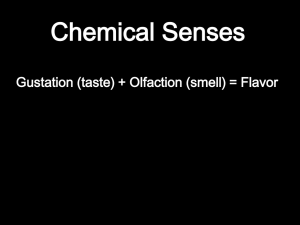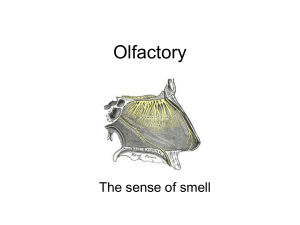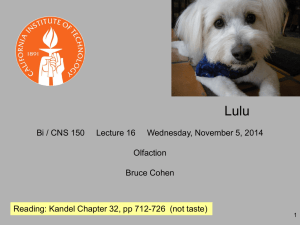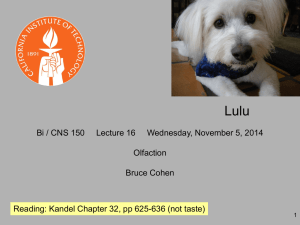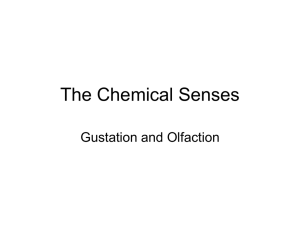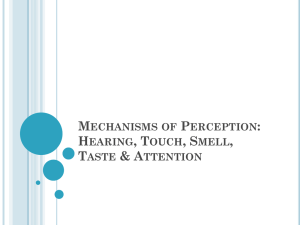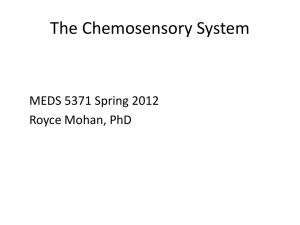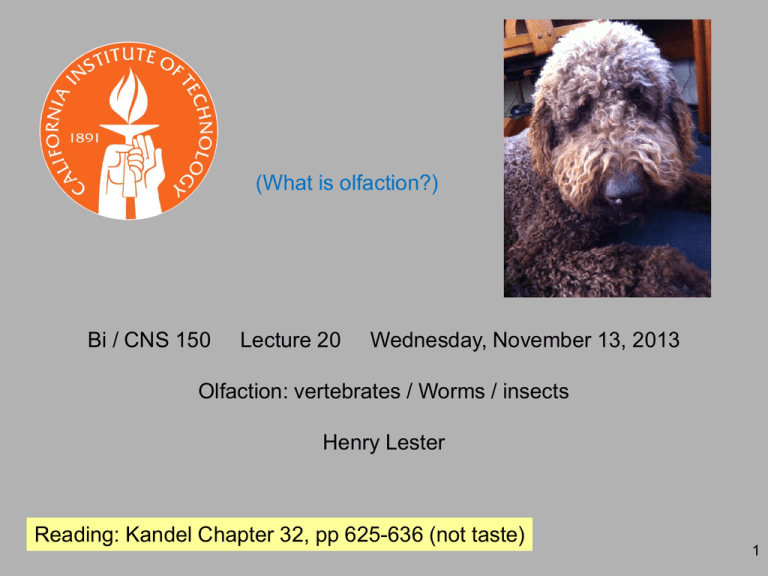
(What is olfaction?)
Bi / CNS 150
Lecture 20
Wednesday, November 13, 2013
Olfaction: vertebrates / Worms / insects
Henry Lester
Reading: Kandel Chapter 32, pp 625-636 (not taste)
1
Proust, Remembrance of Things Past
“as soon as I had recognized the taste of the piece of madeleine soaked in her
decoction of lime-blossom which my aunt used to give me (although I did not yet
know and must long postpone the discovery of why this memory made me so
happy) immediately the old grey house upon the street, where her room was, rose
up like a stage set to attach itself to the little pavilion opening on to the garden
which had been built out behind it for my parents (the isolated segment which until
that moment had been all that I could see); and with the house the town, from
morning to night and in all weathers, the Square where I used to be sent before
lunch, the streets along which I used to run errands, the country roads we took
when the weather was fine . . . “
Olfactory memory
The nose can detect and (in principle) classify thousands of different compounds.
The ‘mapping’ of these compounds probably occurs by matching to memory
templates stored in the brain; thus, a smell is categorized based on one’s
previous experiences of it and on the other sensory stimuli that correlate with its
appearance.
2
Recognition of chemicals by the olfactory system
Carvone
The nose can distinguish very
similar compounds as different
smells.
Stereo center
An example: the two
stereoisomers of carvone smell
like spearmint and caraway.
This implies that there are
stereoisomer-specific carvone
receptors.
An earlier argument for
proteins!
3
Anatomy of the mammalian olfactory system
In many mammals (rodent shown here), the
olfactory organs within the nose are split
into the main olfactory epithelium (MOE)
and the vomeronasal organ (VNO).
MOE neurons project to the main olfactory
bulb (MOB).
VNO neurons project to the accessory
olfactory bulb (AOB).
MOB output neurons project to regions of
cortex, while AOB output neurons project
only to the (ventral) amygdala.
4
Cells of the mammalian main olfactory epithelium
To olfactory bulb
Basal
cells
Axon
Olfactory neurons have
apical dendrites with long
ciliary extensions, where
the transduction
components are located.
Olfactory
sensory
neuron
Dendrite
Supporting
cells
Mucus
Cilia are embedded in the
mucus layer.
Olfactory neurons turn over
and are replaced every 60
days.
Cilia
Figure 32-2
5
Olfactory receptor proteins in vertebrates and most other phyla
Odorants bind to 7-helix (G-protein coupled) receptors.
In mice, >1000 genes (2-3% of genes!) encode these receptors.
Receptor sequences also are quite variable, especially in putative odorantbinding helices.
Thus, the repertoire is extremely diverse.
In mammals, each neuron probably expresses only a single receptor.
6
The start of the G protein pathway in
vertebrate olfaction
Part of
Fig. 32-3
How fast?
100 ms to 10 s
Effector:
membrane-bound
enzyme
activates
G protein
Odorant binds to receptor
outside
inside
b g
a
GTP
How far?
Probably less 1 mm
a
GDP + Pi
7
from Lecture 12
membrane
receptor
G protein
i q s t
effector
channel enzyme
The usual GPCR pathway
intracellular
messenger
Ca2+ cAMP
cytosol
kinase
phosphorylated
protein
8
but in a previous lecture, we said . . .
intracellular
messenger
cAMP
Ca2+ cGMP
Intracellular messengers bind to proteins
kinases
A few ion channels
(olfactory system, retina)
phosphorylated
protein
Previous lecture
NH2
N
N
Ca2+
and
O
O
O
P
-O
O
N
N
H
H
OH
cyclic AMP (cAMP)
9
receptor
G protein
i q olf t
Very similar to Gs
effector
channel enzyme
The GPCR pathway in an
olfactory cell
intracellular
messenger
cAMP
Ca2+ cGMP
channel
10
Olfactory neurons have
cAMP-activated Na+/Ca2+ Channels
receptor
G protein
i q s t
effector
channel enzyme
Excised
“inside-out” patch
allows access
to the inside surface
of the membrane
+cAMP
intracellular
messenger
cAMP
Ca2+ cGMP
channel
no cAMP
no channel openings
open
+cAMP
closed
11
More about olfactory channels and their role in olfactory transduction
Olfactory cAMP-gated channels are permeable to Na+ and Ca2+
Thus, odorant binding causes depolarization of the olfactory neuron through
Na+ entry.
Ca2+ also enters and activates a Cl - channel, increasing depolarization (ECl
is near zero in these cells).
This process stimulates the olfactory neuron to fire action potentials.
12
Olfactory
bulb
Olfactory
epithelium
Expression zones of 4 individual olfactory receptors
(rat nose, coronal section)
Olfactory
receptor
K20
The olfactory turbinates display four ‘expression zones’.
Each receptor is expressed in a small, randomly
K20
distributed subset of neurons within one of the 4 zones
.
As there are ~1000 receptors, about 1/250 of neurons
L45
within a zone express each receptor.
A16
Neurons within each expression zone send axons to a
different quadrant of the olfactory bulb.
Another gene class, expressed in all olfactory neurons
Figure 32-5
13
Projections
to the olfactory bulb
To lateral olfactory tract
Olfactory neurons send axons to the glomeruli (synaptic
balls shielded by glia) of the olfactory bulb.
Olfactory neurons excite mitral cells, which are the bulb
glomus, ball of yarn (Latin)
output cells.
like a bishop’s miter (hat)
Inhibitory
Mitral cell
Tufted
cell
Periglomerular cell
perforated (Latin)
Olfactory sensory neuron
Figures 32-1, 32-6
14
Projections to specific glomeruli
Neurons expressing a specific
olfactory receptor project their
axons to a single glomerulus in
each half-bulb.
Axons converge from many
directions onto the target.
This projection specificity is at
least partly determined by the
receptor itself, but the
mechanisms are unknown.
15
Glomerular odorant responses: Ca2+ imaging in a fish
Individual glomeruli are
selectively activated by
specific odorants.
In fish, “odorants” are
soluble amino acids.
Imaging studies now show
that specific glomeruli in
mammals are also
activated in response to
odorants.
Mice: glomeruli connected to neurons expressing I7, a receptor for octanol, respond
to octanol.
This was also the case if the I7 glomerulus was moved to the wrong place in the bulb
by transplacing the I7 gene into the genomic locus for another receptor.
16
Maps of mitral cell projections to higher olfactory areas
Piriform cortex neurons receive projections from mitral cells corresponding to
many glomeruli that receive input from ORNs expressing different receptors.
Mitral cells also project to olfactory tubercle and other areas.
Integration of odorant responses and odorant identification may take place in
cortex, although some integration is also likely to occur in the bulb.
17
The vomeronasal organ
The VNO is thought to respond to pheromones.
It is a cup-shaped organ near the front of the rodent nose; its neurons are
divided into basal and apical (near the lumen) layers.
The microvilli of the VNO neurons face the lumen.
Neurons in the apical layer express the G protein α subunit Gαi2, while those in
the basal layer express Gαo.
The transduction channel and the receptors are located on the microvilli at the
edge of the lumen.
18
VNO receptor molecules
The 2 distinct families of VNO G protein-coupled receptors are all unrelated to MOE receptors.
Each VNO neuron probably expresses only one receptor, as in the MOE.
V1Rs (~180 genes) are expressed by
V2Rs (~100 genes in the rodent) are
different subsets of neurons within the
expressed in a random pattern by basal layer
apical layer (Gi-expressing neurons).
neurons (Go-expressing neurons). V2Rs have
large N-terminal extracellular domains.
Figure 32-9
19
The GPCR pathway in a VNO cell
receptor
G protein
i q s t
effector
channel enzyme
intracellular
messenger
Ca2+
cAMP
cGMP
IP3
DAG
channel
20
(like the GPCR lecture)
VNO signal transduction
TRPC2 channel
phosphatidyl inositol
4,5 bisphosphate = PI(4,5)P2
Like Alberts 15-36
© Garland
21
Response characteristics of VNO neurons
VNO neurons respond to urine.
Some neurons selectively respond to urine from mice of the same sex,
others to urine of the opposite sex.
Unlike ORNs, their responses are narrowly tuned; no neurons were ever
observed to respond to more than one compound.
A behavioral assay: mice produce ultrasonic calls (‘whistling’) in response
to contact with urine from the opposite sex; production of these calls
requires both the VNO and the MOE.
In TRPC2 knockout mice, VNO neurons do not respond to urine; and mice
do not vocalize in response to urine
22
AOB projections to the brain
Mitral cells in the AOB have apical dendrites that arborize in multiple glomeruli.
The AOB projects to the amygdala (directly), and the hypothalamus (via the
amygdala).
The projections from the rostral and caudal AOB halves are superimposed in the
amygdala.
This implies that integration of pheromone signals may take place primarily in the
AOB.
23
Generalities about main olfactory system and vomeronasal system function
The main olfactory system mediates cortical responses to volatile odorants,
and these cortical responses are used to drive conscious behavior (foodseeking, predator avoidance, etc).
The VN system is thought to mediate unconscious responses to water-soluble
pheromone compounds found in urine and secretions of other individuals.
24
Loss of VNO signaling
eliminates aggressive
responses to intruders
TRP2 = TRPC2
Normal male mice attack intruders introduced into
their territory, especially intruders swabbed with male
pheromone.
TRPC2 knockout mice
lack this response.
TRPC2 knockout males mate normally with females.
Remarkably, though, they also mount males, which control mice never do.
The TRPC2 knockout phenotype suggests that the ‘default’ pathway in the absence of
VNO input is to mate with everything.
VNO input causes male mice to fight rather than attempt to mate
25
Chemical nature of pheromones
The various pheromones include
prostaglandins in fish,
androstenone in pigs, and
protein ligands such as hamster aphrodisin.
In most cases, however, individual pure compounds don’t elicit strong responses.
Natural pheromones are mixtures of many substances,
perhaps combinations of (protein carriers) plus (bound small organic compounds).
26
A genetic model system: nematode olfaction
C. elegans can chemotax toward
and away from volatile attractants
and repellents.
It uses only two pairs of neurons,
AWA and AWC, to respond to
volatile attractants.
It has many olfactory receptors,
however, so each chemosensory
neuron must express many of
these.
The ODR-10 receptor is expressed
in AWA and localized to its
dendrite.
ODR-10 is a receptor for the
odorant diacetyl (2,3 butanedione).
Worms lacking ODR-10 are not
attracted to diacetyl.
Figure 32-11
27
ODR-10 phenotype
ODR-10 is specific for diacetyl and does not respond to 2,3-pentanedione,
which differs by only one methylene group.
ODR-10 mutants still chemotax to 2,3-pentanedione
The AWC cell has receptors for 2,3-pentanedione
Deletion of AWC destroys chemotaxis to 2,3-pentanedione
28
ODR-10 recognizes components of a metabolic pathway
What is the selective advantage of a worm’s response to diacetyl?
Diacetyl results from respiration by certain bacteria.
These bacteria often use citrate as a carbon source.
ODR-10 also recognizes the metabolic intermediates citrate and pyruvate.
Diacetyl is a volatile signature compound for certain bacterial species.
Many other bacteria do not make diacetyl but do make acetoin or lactate as
respiratory endproducts.
Diacetyl attraction thus allows the worm to recognize specific food sources at
a distance in the soil.
Citrate and pyruvate (nonvolatile) interactions with ODR-10 may provide
taste-like recognition of these bacteria after the worm arrives at their colony.
29
A Recent Surprise: Insect Olfactory Receptors are Probably
Ligand-gated Channels
Encoded by one of ~ 60 genes
For structure of the Drosophila
olfactory system, see Fig. 32-10
An auxiliary subunit, common to most
insect olfactory receptors.
Also called Or83b, Or1, Or2, and Or7.
Terminology is converging on “Orco”
30
“Metabotropic signalling in vertebrates provides a rich panoply of positive and negative
regulation, whereas ionotropic signalling in insects enhances processing speed.”
Kaupp, Nature Revs. Neuro, 2010
31
End of Lecture 20
32

